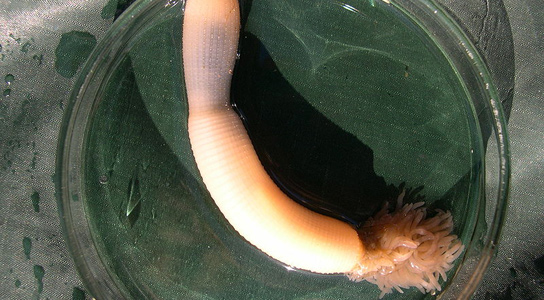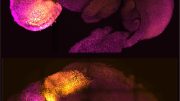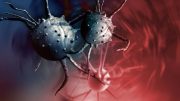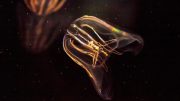
A Priapus caudatus worm. Credit: Wikipedia
A new study on the development of priapulids, known colloquially as penis worms, throws doubt on a feature that has been thought to define one of the largest groups of animals for more than a century.
The researchers published their findings in the journal Current Biology. Protostomes have historically been defined by the order in which they develop a mouth and an anus as embryos. However, gene-expression data suggests that this is incorrect.
There might be a need to rename the protostome class of animals. There are tiny differences in how embryos develop in the different branches in the tree of life, which can lead to monumental changes in adults. When an embryonic ball of cells develops two indentations instead of one, the organism will develop a separate mouth and anus contrary to the single opening that jellyfish and sea anemones have. In 1908, animals with both a mouth and anus were divided into two groups. The protostomes formed their mouth first, the anus second. In the other animals, the mouth formed after the anus.
Protostomes include priapulids and other invertebrates. Deuterostomes include vertebrate animals, like humans, and some spineless animals. Tracing how cells divide in all organisms remains technically challenging; however, by using DNA sequence data, it’s been possible to see the general shape of this evolutionary tree.
Molecular techniques that have used the analysis of gene expression have revealed that a primitive protostome, Priapus caudatus, develops like a deuterostome. These animals are living fossils, since they haven’t changed much in millions of years, and look almost identical to their ancestors, which littered the ocean floor during the Cambrian period. This suggests that early protostomes developed differently. The order of the mouth and anus is now uncertain.
Other similarities, like DNA sequences indicate that priapulids are closely related to protostomes. This is not the first report of a maverick protostome. Embryologists have previously noted variations in how protostome mouths develop.
Reference: “Deuterostomic Development in the Protostome Priapulus caudatus” by José M. Martín-Durán, Ralf Janssen, Sofia Wennberg, Graham E. Budd and Andreas Hejnol, 25 October 2012, Current Biology.
DOI: 10.1016/j.cub.2012.09.037









Be the first to comment on "Priapulid Worms Highlight Need to Rename A Group of Animals"